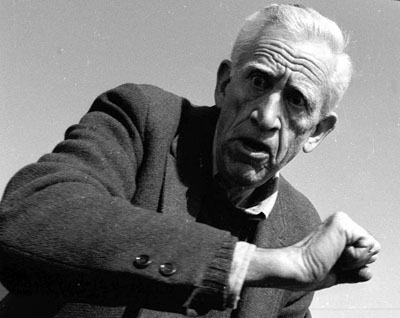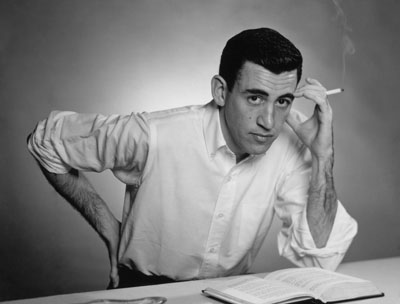As Jeremy Kay reports for Screen Daily, Toronto‘s added a special screening, happening tonight, of Salinger, which premiered at Telluride and is set to open in a few theaters this weekend. It’s been nearly two weeks now since we learned that the big reveal of Shane Salerno’s documentary and the book he’s co-authored with David Shields is that rumors of unpublished work stored away in a vault are true. At least five books are being prepared for publication, beginning in 2015. One catches up with Holden Caufield, another with the Glass family, and further volumes tackle World War II, Salinger’s first marriage, and the Vedanta.
That aside, the doc “is an outsized A&E Biography episode, coursing with the strident urgency typical to anyone convinced they have something new to say on a long since played-out topic,” writes Steve Macfarlane for Slant. “The film is too engorged on its rich subject matter to be a beginner’s guide, but also too maudlin and faux-encyclopedic to clang with the resonance of a truly personal or artistic analysis…. Rather than Jerome Davis Salinger himself, Salerno’s insatiable lust to put the man on screen emerges as the movie’s true subject.”
In the Guardian, Tom Shone reminds us that Salerno is “the screenwriter who gave us Michael Bay’s Armageddon, Oliver Stone’s Savages, and other such sylphine tributes to innocence lost…. This is very much Salinger in the eyes of Hollywood, with lots of ambition, demons, plushly exaggerated love interest, a portentous score that never quite dispels the suspicion that Bruce Willis will soon arrive and start blasting asteroids, plus an array of talking heads plucked from Harvey’s Rolodex: Martin Sheen, Philip Seymour Hoffman, Ed Norton, even—God bless him—Judd Apatow, prompting the unbidden thought that Holden Caulfiled could easily have slipped into the cast-list of Freaks and Geeks, no question.”
The Voice‘s Alan Scherstuhl puts it more bluntly: “Salerno’s film is two bombastic, bullshit-packed hours of proof that Salinger and Caulfield were right to hide out from Hollywood.”
“As both book and film amply document,” writes Salon‘s Laura Miller, “the author was a terrible father and worse husband, a man who withdrew from public life and repudiated his fame, yet was not above using that fame (via creepily seductive letters) to court teenage girls from his redoubt in Cornish, N.H…. It’s not always easy to accept that what gives some artists their access to greatness can also stunt them as human beings. In a few, rare cases, the work transcends the hobbled souls who created it. Only nostalgia could interest me in the further adventures of Holden or the Glass family. But also waiting in that cache of manuscripts are at least two books about grown-ups, set during the war, and I am more than a little curious to see what Salinger made of that.”
More on Salinger: Andrew Barker (Variety; “a long-winded carnival-barker pitch”), Stephen Farber (Hollywood Reporter; “another example of hype outpacing actual achievement”), Eric Kohn (Indiewire, B+), and Chris Willman (Playlist, B+). And Katie Van Syckle gets a few words with Salerno for Vulture.
Updates: In a fresh post at the New Yorker, Adam Gopnik reminds us that Mark Chapman “hallucinated a motive” in The Catcher in the Rye for shooting John Lennon. “Shields and Salerno’s own peculiar view of Salinger forces them to insist that Chapman was not just a crazy hallucinant, but in his own misguided way an insightful reader, responding to the ‘huge amount of psychic violence in the book.’ … That Chapman’s reading strikes the authors as logical, if unfortunate, is just one demonstration, in a strange chop-shop biography, that they are no more interested in Salinger the writer or artist than the people who go through Dylan’s garbage cans are really interested in Dylan. In both book and bad movie, a simple theory is flogged: that Salinger was a victim of P.T.S.D., screwed up by a brutal combat experience in the Second World War. It’s a truth that, as far as it goes, Salinger himself dramatized at beautiful length in his story ‘For Esmé—with Love and Squalor,’ and then left behind…. The subject of the book and documentary is not Salinger the writer but Salinger the star: exactly the identity he spent the last fifty years of his life trying to shed.”
At Twitch, Peter Martin notes that Salerno’s primarily interested in “proving a correspondency between real life and fiction. This is a very shaky premise, depending on the hypothesis that all fiction is no more than real life with the names changed.”
Salinger is a “staggeringly idiotic” documentary, argues Nathan Rabin at the Dissolve. “It is everything the Salinger of his books was not: predictable, cliched, banal, and worst of all, phony.”
“When Salinger succeeds,” writes Kyle Ryan at the AV Club, “it’s in spite of Salerno’s heavy hand and because of the implicit intrigue of J.D. Salinger’s life story. For a director who clearly reveres his subject’s work, he doesn’t grasp how the flashy, eardrum-busting pomp and circumstance of his film is exactly the kind of thing Salinger abhorred.”
Updates, 9/7: Harper’s has posted Mary McCarthy‘s 1962 piece, “J.D. Salinger’s Closed Circuit”: “Salinger’s world contains nothing but Salinger, his teachers, and his tolerantly cherished audience—humanity; outside are the phonies, vainly signaling to be let in…”
For David Ehrenstein, writing here in Keyframe, Salinger is “an intellectual peepshow, much like its subject. For J.D. Salinger’s story is a search for ‘wisdom’ producing not a sage but a ‘control freak.’ We’re given a glimpse of ‘everything’ and the result is nothing special. Just another neurotic, albeit one with some degree of literary talent, lucky enough to come equipped with a cheering section that has stood him in good stead throughout his life and now doubtless well beyond the grave.”
Salerno’s doc “is less a work of cinema than the byproduct of its own publicity campaign,” writes A.O. Scott in the New York Times. “It does not so much explore the life and times of J.D. Salinger as run his memory and legacy through a spin cycle of hype. Salinger moved to the woods of New Hampshire partly to escape the intrusions and indignities of American celebrity culture. Salinger is that culture’s revenge.”
Similarly, New York‘s David Edelstein writes that “the movie is everything—in a single place, perfectly distilled—that made Salinger’s skin crawl enough to renounce the world.”
Salinger “had definitively lost me (and, judging by the snickers, much of the rest of the audience) by the time it got to the log-toting scene,” writes Slate‘s Dana Stevens. “This image—of a beefcakey young actor playing Salinger, nobly shouldering a large piece of timber as he hiked alone through the New Hampshire countryside—came near the end of a slapdash first hour… The log-tote wasn’t the first time Salinger employed the re-enactment technique familiar from countless History Channel infotainments, but it seemed to mark the moment in which the movie committed fully to its tone of solemn, literal-minded vulgarity.”
For Vanity Fair, Bruce Handy presents “eight shocking Salinger secrets its makers and distributor would rather you not know! 1. It’s awful.”
It’s also “ultimate invasion of its subject’s privacy,” writes Odie Henderson at RogerEbert.com.
“If you are only interested in Salinger news, you might be better off reading a newspaper article listing the film’s revelations,” suggests David D’Arcy. “Here is a snarky précis from the Daily Beast. Salinger the doc is made for PBS, and looks like it—that’s not a compliment.”
Update, 9/12: “Here I thought I’d addressed all the necessary Salinger questions a few months ago when I discovered the newly donated Salinger letters at the Morgan Library and wrote about Salinger’s obsession with Vedantism and the price his fiction paid for his flight into what I called ‘spiritual self-medication,'” sighs Ron Rosenbaum at Slate. “I argued that that ‘spiritual self-medication,’ so necessary to save his mind from wartime horrors, stole his soul in a way—or in any case stuffed his later prose with undigested mystical didactism. Certainly the later Glass family stories suffered for centering on the insufferable Seymour, the purported ‘holy man’ and Vedantic sage, with whom I finally was so fed up I called him a ‘mystical windbag.’ But the new Salinger book and film have pulled me back in, because they both perpetuate a fundamental mistake about The Catcher in the Rye, a mistake worth correcting.” And that would be “that Salinger and Holden are the same.”
Update, 9/17: Shields and Salerno have “interpreted Salinger’s work with blustery overconfidence, essentially reducing four of the most vulnerable works in American literature to aesthetic products of posttraumatic stress disorder,” argues Cornel Bonca in the Los Angeles Review of Books.
Update, 9/19: “A lurid wash of bombast and surmise, the nonfiction collage-cum-stalkumentary called Salinger lacks even the decency to find a filmmaking form in which to nest its shaggy head,” writes Ray Pride at Newcity Film.
2013 Indexes: Telluride and Toronto. For news and tips throughout the day every day, follow @KeyframeDaily on Twitter and/or the RSS feed. Get Keyframe Daily in your inbox by signing in at fandor.com/daily.





